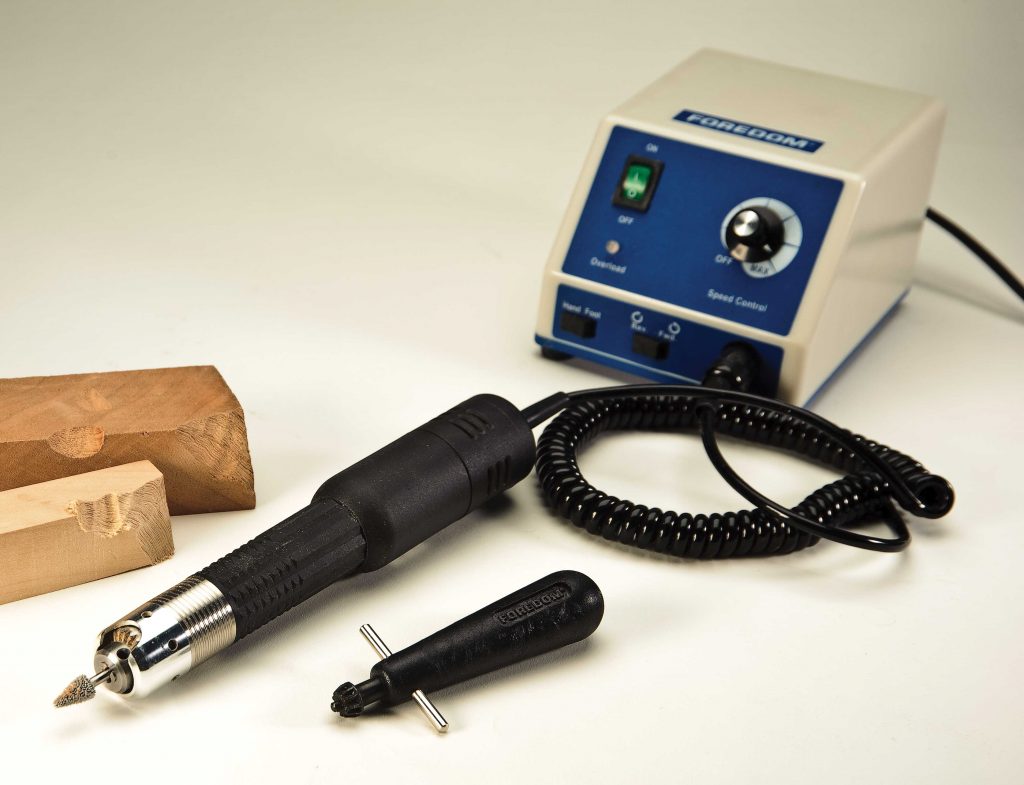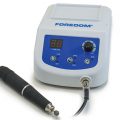 By Bob Duncan
By Bob Duncan
Foredom has developed a new micro grinder that bridges the gap between large flexible-shaft tools and high-speed micromotors. The K.1020 micro grinder combines the torque and power you need to rough out a carving with the light-weight cord of a micromotor.
The micro grinder hooks into the standard K.1070 micromotor control unit and has a flexible cord like a micromotor, which means you won’t be fighting a stiff flexible shaft. The micro grinder weighs 19 ounces, which is more than the 9 ounces a standard micromotor weighs, but the unit is much easier to wield than a traditional handpiece on the end of a flexible shaft.
The micro grinder’s three-jaw chuck only accepts bits with shafts up to 5⁄32” (4mm) in diameter, so you will not be able to use large carbide-point bits with this tool. But the tool quickly removes wood with carbide-point bits with 1/8″ (3mm)-diameter shafts.
The micro grinder’s top speed is around 20,000rpm, which is higher than an average flexible shaft tool’s top speed of 18,000rpm, and lower than an average micromotor’s top speed of around 38,000rpm.
I chucked a round-nose cylinder-shaped bit into the micro grinder and set the control unit at around half speed. I carved away at a piece of basswood and was shocked at how fast the wood disappeared. The dust flew even faster when I pressed down harder, but the tool didn’t slow down. The bit barely slowed until I literally buried the bit inside the rapidly growing hole
I was carving. After carving to a depth of 5/8″ (16 mm), the overload switch finally tripped.
I turned the unit to maximum speed and tried the same bit on a piece of black cherry. The wood didn’t disappear quite as fast, but the tool still performed admirably. I buried the bit nearly 1/2″ (13mm) into the wood before the overload switch tripped.
I then tried a 3⁄32” (2.5mm)-diameter ceramic rod. Ceramic rods are usually used to add fine details to a carving. With the speed turned the whole way up, I was able to carve in detail lines nearly as easily as if I were using a traditional micromotor. It will always be easier to carve details with the higher speed of a micromotor, but the speed and dexterity of the micro grinder was impressive. The three-jaw chuck makes it easy to switch between bits with different diameter shafts without fussing with collets or adaptors.
Foredom’s micro grinder is not intended to replace flexible-shaft tools where you’d use large carbide-point bits to rough out sizeable carvings. The micro grinder is ideal for songbirds and other carvings under 12″ (305mm) tall and can easily replace a flexible-shaft tool when working with these smaller carvings.
The K.1020 micro grinder kit is available for $499. If you already have the K.1070 micromotor kit with the control switch, you can purchase the micro grinder separately for $325. For more information, contact Foredom at 203-792-862 , www.foredom.com.






